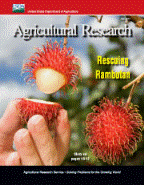United States Department of Agriculture: Agricultural Research Service, Lincoln, Nebraska

Agricultural Research Magazine
Date of this Version
8-2013
Document Type
Article
Citation
Agricultural Research 61(7): August 2013; ISSN 0002-161X
Abstract
“A big part of our Agricultural Research Service culture is cross-talking with outside researchers,” says ARS soil and water scientist Patrick Hunt. “Partnerships are what we do.”
So one day in 2011, Hunt called Medical University of South Carolina professor Daniel Lackland to discuss a paper Lackland had published about stroke risk in the state. South Carolina is part of the U.S. “Stroke Belt,” where residents have a significantly higher incidence of stroke than the rest of the U.S. population. South Carolina counties with the highest rates of stroke—between 89 and 115 cases per 100,000 residents—are found within the Southern Coastal Plain, which “buckles” the Stroke Belt (see map).
Lackland had determined that South Carolina stroke victims in the state’s Pee Dee region—located in the Stroke Belt “buckle”—were on average 10 years younger than stroke victims outside the Belt. His studies also indicated that individuals born in the Stroke Belt have an increased risk of stroke in their lifetime, a risk that remained even if they moved away from the Stroke Belt later. He had identified some very intriguing trends, but he did not fully understand what might be driving those trends.
Included in
Agriculture Commons, Animal Sciences Commons, Food Science Commons, Plant Sciences Commons

